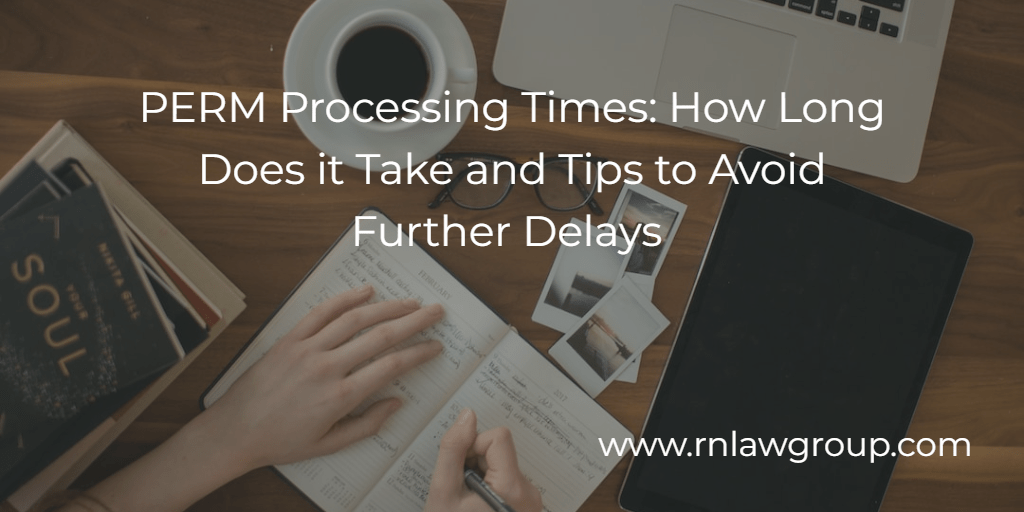
PERM Processing Times: How Long Does it Take and Tips to Avoid Further Delays
The PERM Labor Certification (PERM) process is often the first of three steps to the employment-based green card process. The PERM process itself involves multiple steps, including the following:
- Determine the job description and minimum requirements for the job opportunity: Getting this step right is key – developing the job description is a very important step and forms the core of the PERM application. Generally, the employer will need to provide the job duties, job description, and minimum requirements for the sponsored position. This step sometimes requires a lot of back-and-forth between the employer and the employer’s attorney to ensure all aspects of the position are correctly accounted for. Also, it is crucial to verify at this step that the foreign worker meets all requirements for the position and that all qualifications can be properly documented.
- Obtain a Prevailing Wage Determination (PWD): Employers must obtain a PWD from the Department of Labor’s National Prevailing Wage Center (NPWC). The employer must offer the foreign worker the prevailing wage rate or higher for the sponsored position. TheNPWC issues PWDs based on multiple factors, including, but not limited to, the area of intended employment, job title/job description, minimum requirements for the position, and any required travel. A PERM application cannot be filed without a valid PWD.
- Conduct Recruitment: In addition to obtaining a PWD, employers must also conduct recruitment for the sponsored job opportunity to test the U.S. labor market for able, willing, qualified, and available U.S. workers. This is the heart of the PERM labor certification process. The recruitment process involves advertising in multiple DOL mandated mediums. Based on strict regulatory timelines, it will take aminimum of 60 days for employers to complete recruitment. However, the recruitment process often exceeds 60 days for multiple reasons. For example, if resumes are received from U.S. workers, employers may still be conducting interviews beyond the 60-day period.
- File the PERM application: The PERM application can only be filed if there are no able, willing, qualified, and available U.S. workers found for the position during the recruitment process. If no such workers are found, the next step is to prepare and file ETA Form 9089, also known as a PERM application. The ETA Form 9089 requires detailed information about the employer, the job position, and the foreign worker. Employers must provide all required information accurately and completely in order to avoid issues that could lead to a denial of the application. Once the application is ready to file, it will be submitted electronically through the Foreign Labor Certification Permanent Online System.
- Adjudication of the PERM application: After the PERM application is submitted, the Department of Labor will review the application to determine whether the employer meets all PERM requirements. The Certifying Officer will either issue a straight approval of the application or issue a PERM audit (for more information on PERM audits, visit Minimize Your Risk of PERM Audit).
Where Do PERM Processing Times Stand?
The Department of Labor (DOL) has issued updated processing times as of February 28, 2023 for prevailing wage determination requests and March 09, 2023 for PERM applications. The updated processing times are as follows:
Prevailing Wage Determination Processing Times
According to the DOL, the NPWC is processing PWDs that were filed in January 2022 for both OES and non-OES wages.
Further, the NPWC is processing redetermination requests submitted in June 2022.
The NPWC’s reported processing times are what the agency considers to be within normal processing times. This means that PWDs can be processed sooner. Currently at Reddy Neumann Brown PC, we are seeing PWDs being issued in about 6-7 months on average.
DOL has indicated the following reasons for the long PERM PWD processing times: (1) An increased demand on their resources, partly due to the record number of H-2A/H-2B filings; and (2) the 2018 Standard Occupational Classification (SOC) implementation. Specifically, OFLC is lacking the critical baseline information for some of the new SOCs, making it more difficult to determine the normal requirements for an occupation and the wage level for a particular occupation.
PERM Processing Times
The DOL is processing PERM applications filed in June 2022. On average, the DOL is adjudicating PERMs in approximately 262 days (over 8.5 months!).
Further, the DOL is processing audits for PERM applications filed in March 2022. On average, processing times for audit review is 363 days. Therefore, if the PERM application was audited, expect an additional 3-4 months for adjudication. Additionally, the DOL is processing PERM reconsideration requests that were submitted in July 2022.
Currently at Reddy Neumann Brown PC, we are seeing PERM applications approved on average in about 8 to 8.5 months, which is consistent with the average processing times reported by the DOL
Tips to Avoid Further Delays in PERM Processing
The PERM Labor Certification process is complex, involves multiple steps, and requires careful attention to detail. Adding to this already stressful process, PERM processing times are currently at an all-time high with no improvement in sight. Unfortunately, premium processing is not available for PWDs or PERM applications, but here are a few things employers can do to help avoid further delays in the process:
- Begin recruitment while the PWD is pending: Currently, employers who begin recruitment while the PWD request is pending may be able to file a PERM application in 6-7 months as opposed to 8-9 months. Essentially the goal is to be able to file the PERM application as soon as the PWD is issued by the NPWC. This is of course assuming that recruitment is complete by the time the PWD is issued. Although this option may offer a faster track to filing a PERM application, there are risks involved. Therefore, employers may only want to utilize this option in urgent situations (e.g. H-1B max out date is approaching). It is important to speak with an immigration attorney to go over the pros and cons in detail.
- Register with the Foreign Labor Certification Permanent Online System: This system is the electronic system used to file and process PERM applications. The system allows employers and their representatives (attorneys/agents) to create and prepare PERM applications and submit them to the DOL for processing online as opposed to mailing an application to the Department of Labor. Also, employers want to be sure to register an account early on in the process to avoid any filing delays once the PWD is issued and recruitment is complete.
- Ensure the PERM application is accurate: Before submitting a PERM application, ensure that all portions of the form are completed properly. This includes typographical errors. PERM was implemented to streamline the labor certification process. Therefore, the DOL does not easily overlook errors on the application. In fact, even a seemingly minor error can cause denial of your PERM application. It is important that the PERM application is thoroughly reviewed for substantive and non-substantive errors before submission to the DOL. Otherwise, the processing of the PERM application may be delayed.
- Ensure the Foreign Worker Qualifies: Employers should confirm the foreign worker’s qualifications at the beginning of the process to ensure the worker fully qualifies for the job opportunity. Employers do not want to find out at the time of filing that there is an issue with the employee’s qualifications. This may require the employer to start over from the beginning, causing major delays in the process.
- Avoid audit triggers: The DOL does not require that the employer provide supporting documentation when submitting a PERM application. Therefore, the DOL implements a quality control process in the form of PERM audits to ensure full compliance with all regulations. Although audits can be issued at random as part of the DOL’s quality control process, there are certain audit triggers that can be recognized from the beginning of the process. Understanding these triggers may provide employers with an edge going into the process. For a list of audit triggers, please see my previous article: Minimize Your Risk of PERM Audit by Recognizing These Audit Triggers.
- Be prepared in the event of an audit: In the event of an audit, employers will be required to submit certain documentation to the DOL’s Certifying Officer. This documentation includes, but is not limited to: All posted advertisements for the job opportunity, resumes/applications received during the recruitment process, and a recruitment report detailing the lawful job-related reasons for rejection of U.S. workers. Following the regulatory requirements of the recruitment process is essential to avoid a possible denial if an audit is issued. Therefore, employers must keep an organized record of all recruitment activities prior to filing a PERM application. This will help ensure that the audit response is quickly submitted by the employer and an approval is issued after audit.
- Consider premium processing of the I-140 Petition: Unfortunately, premium processing is not available for PWDs or PERM applications. However, once the PERM application is finally approved, an employer may want to consider filing the I-140 petition in premium processing, especially in urgent situations. Premium processing will allow the I-140 to be adjudicated in 15 days if no request for evidence is issued.
- Work with an experienced immigration attorney: PERM is very complex and one simple mistake can derail the entire process. Employers should strongly consider working with an experienced immigration attorney to help navigate the complexities of the PERM Labor Certification process to help ensure a successful outcome. Here are a few articles highlighting the complex nature of the PERM process:
PERM processing times continue to be a serious issue for both employers and foreign workers. It’s important to remember that although there are options to prevent further delays in the PERM process, there are no guarantees and employers are still limited in how fast applications can be processed due to the regulatory requirements involved. Therefore, to prevent potential problems with the foreign worker’s temporary work visa and ability to remain and work in the U.S. beyond the maximum period of stay, employers should plan to start the employment-based green card process as early as possible.
Reddy Neumann Brown PC is dedicated to helping our clients navigate the PERM labor certification process and the ongoing immigration difficulties that result from lengthy PERM processing times. We will continue to keep you updated on changing PERM processing times. If you have any questions, please consider scheduling a consultation at Appointments
Krystal Alanis is a Partner at Reddy Neumann Brown PC with over 10 years of experience practicing U.S. business immigration law. Krystal manages the firm’s PERM Labor Certification Department, where she oversees all EB-2 and EB-3 employment-based green card matters. Krystal guides clients from a variety of industries through the maze of the PERM Labor certification process and has handled thousands of PERM applications throughout her career. Krystal guides employers through the I-140 and Adjustment of Status process, and assists clients with temporary work visas. Further, she oversees the firm’s I-9 compliance team where she advises employers regarding Form I-9 Employment Eligibility Verification requirements and conducts internal audits of a company’s I-9 records, processes, and procedures. Additionally, Krystal represents clients in Form I-9 U.S. Immigration and Customs Enforcement (ICE) inspections (Notice of Inspection). Krystal successfully settled a claim with ICE over Form I-9 substantive paperwork violations that led to an 88% reduction in civil fines for her client.

